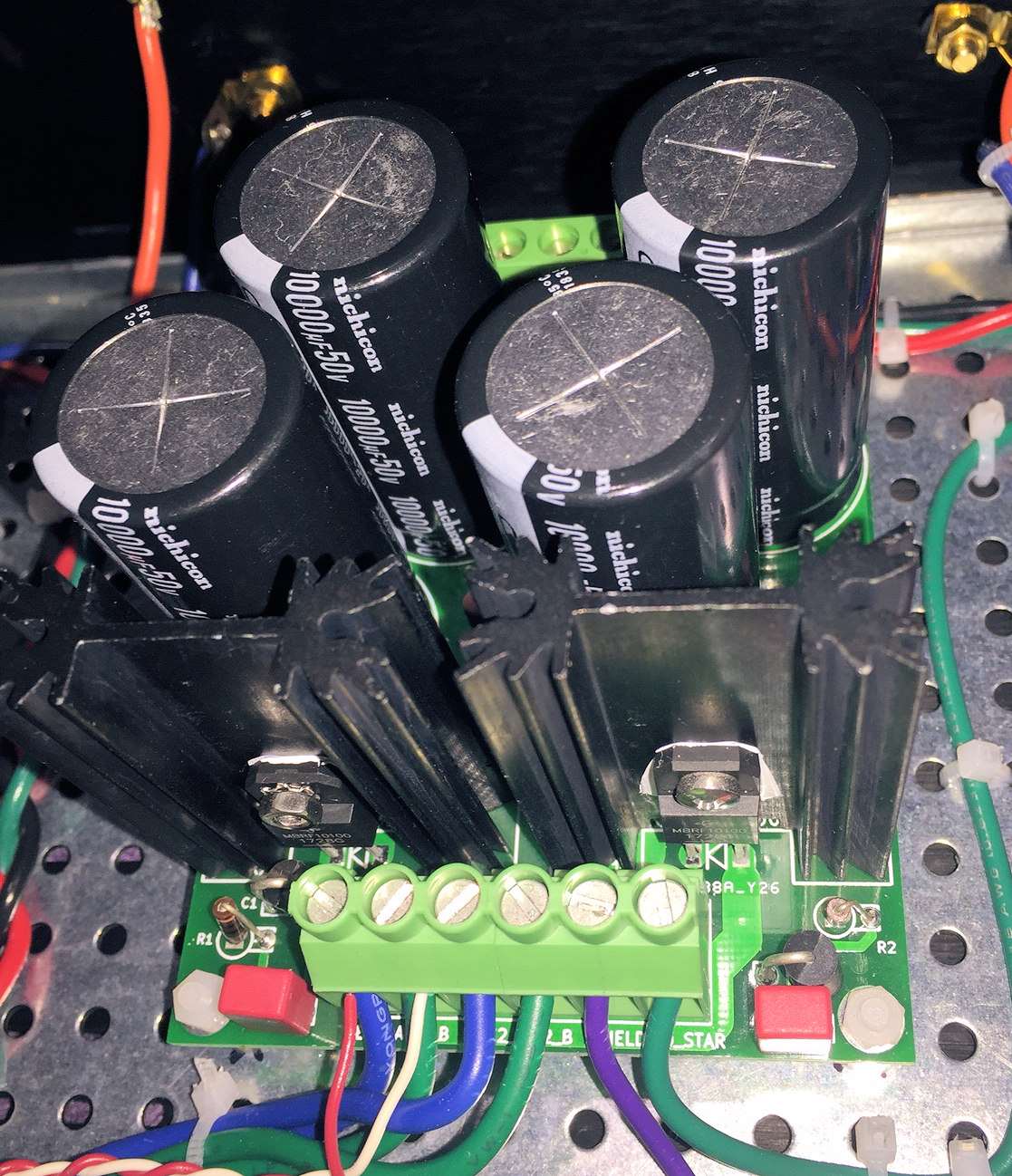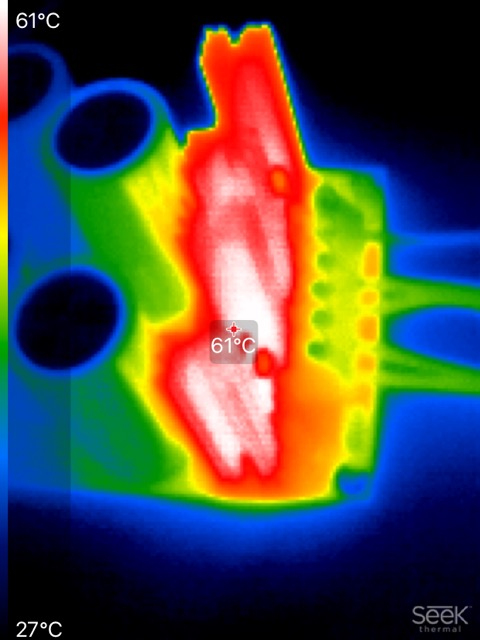@trobbins,
no if´s nor but´s , eight modules running two years one blew because of a leaking cap, So to prevent further mishap I changed all caps on them. Is all.
Their rated voltage is 36 volts and their rated current is 5 amps. A real life test of 2 years .
But MAYBE you can kindly explain to me how you go about asking a leaking cap in a cheap chinese smps why it has commited the crime. The things cost about 10 $ each so one out of eight is not so bad I would say . And IF you can give me some advice about how MAYBE I could extract a useful answer out of a cap that leaked it´s electrolyte ? Faulty manufacture? Dried out and rising ESR? Faked Part? 😀
no if´s nor but´s , eight modules running two years one blew because of a leaking cap, So to prevent further mishap I changed all caps on them. Is all.
Their rated voltage is 36 volts and their rated current is 5 amps. A real life test of 2 years .
But MAYBE you can kindly explain to me how you go about asking a leaking cap in a cheap chinese smps why it has commited the crime. The things cost about 10 $ each so one out of eight is not so bad I would say . And IF you can give me some advice about how MAYBE I could extract a useful answer out of a cap that leaked it´s electrolyte ? Faulty manufacture? Dried out and rising ESR? Faked Part? 😀
Sorry, I missed that you had started the thread 2 years ago.
The output e-caps would need ventilation thought about, given their location. With only one failure, and no assessment of the ripple current they are subjected to, or measurement of the local ambient temperature you were subjecting them to in your 2 yr trial, or measurement of ESR of the removed caps, then your comment about the caps being the weak point is only a guess, as is the need for lower ESR versions.
If you can measure the cap ripple current at your test load, and measure the local ambient temp that the cap is sitting in, and try and measure the cap top metal temperature, then you can estimate the life of a cap that has got available specs and compare it with the life that you got from that one failure. You can then work through whether you can lower the load current (to lower ripple current), and/or lower the local ambient temp, and/or replace the caps with a known spec part, and then do some engineering calcs and put a reminder in your calendar to replace the caps in X months time.
As with pretty much all these single board modules, how they are cooled is often the biggest issue to manage. As such, simply saying they are no good above a certain % of rated output is imho too simple a statement to make.
The output e-caps would need ventilation thought about, given their location. With only one failure, and no assessment of the ripple current they are subjected to, or measurement of the local ambient temperature you were subjecting them to in your 2 yr trial, or measurement of ESR of the removed caps, then your comment about the caps being the weak point is only a guess, as is the need for lower ESR versions.
If you can measure the cap ripple current at your test load, and measure the local ambient temp that the cap is sitting in, and try and measure the cap top metal temperature, then you can estimate the life of a cap that has got available specs and compare it with the life that you got from that one failure. You can then work through whether you can lower the load current (to lower ripple current), and/or lower the local ambient temp, and/or replace the caps with a known spec part, and then do some engineering calcs and put a reminder in your calendar to replace the caps in X months time.
As with pretty much all these single board modules, how they are cooled is often the biggest issue to manage. As such, simply saying they are no good above a certain % of rated output is imho too simple a statement to make.
Last edited:
Here's a fun thing you can do with electrolytic capacitors in power supplies: take infrared pictures.
Click on each image to see it undistorted and full sized.


You can see that the electrolytic cans have a big zone of green-temperature (about 44 deg C) with a small region of yellow-orange-temperature (about 50 deg C). Then you can check the temperature-versus-lifetime equations on pages 13-16 of Cornell Dubilier's application guide, attached below.
Very curious readers might zoom in to the diodes in the photograph: yes those are Schottky rectifiers! And despite their low Vfwd, them babies are getting mighty dadgum hot.
_
Click on each image to see it undistorted and full sized.
You can see that the electrolytic cans have a big zone of green-temperature (about 44 deg C) with a small region of yellow-orange-temperature (about 50 deg C). Then you can check the temperature-versus-lifetime equations on pages 13-16 of Cornell Dubilier's application guide, attached below.
Very curious readers might zoom in to the diodes in the photograph: yes those are Schottky rectifiers! And despite their low Vfwd, them babies are getting mighty dadgum hot.
_
Attachments
@Mark Johnson :
your attached files about caps are extremely recommendable info for anyone and especially beginners. Cheerio
@trobbins :
your scientific approach is , of course , exellent and commendable but I personally take another more practical approach for several reasons.
First one being that if I were to do that with every problem I encounter I would need to double my lifetime just for that .
Taking reason 1 as a given the second is that three caps of 50v470uf and 105degrees are 1,50 euros so it is easier and cheap to simply change them as it is well known that the chinese have a tendency towards cheap and often even fake capacitors , among other things like chips and mosfets for example. They want to offer cheap and make money in spite of it after all .
And reason Nr.3 , last but not least , is that for many members of the forums here who are not engineers a practical solution which is not too expensive seems to be better to me than a technical approach beyond their means both in knowledge and available instrumentation and mainly the latter .
I know that I personally can analize this to the nth ! degree but is is worth it ? No it is not because in that case I buy a high class smps instead of these cheap modules , with an ample margin of power. The real point here is to buy cheap and get away with it . Which is one of the main reason lots of people get into DIY in the first place is it not ?
your attached files about caps are extremely recommendable info for anyone and especially beginners. Cheerio
@trobbins :
your scientific approach is , of course , exellent and commendable but I personally take another more practical approach for several reasons.
First one being that if I were to do that with every problem I encounter I would need to double my lifetime just for that .
Taking reason 1 as a given the second is that three caps of 50v470uf and 105degrees are 1,50 euros so it is easier and cheap to simply change them as it is well known that the chinese have a tendency towards cheap and often even fake capacitors , among other things like chips and mosfets for example. They want to offer cheap and make money in spite of it after all .
And reason Nr.3 , last but not least , is that for many members of the forums here who are not engineers a practical solution which is not too expensive seems to be better to me than a technical approach beyond their means both in knowledge and available instrumentation and mainly the latter .
I know that I personally can analize this to the nth ! degree but is is worth it ? No it is not because in that case I buy a high class smps instead of these cheap modules , with an ample margin of power. The real point here is to buy cheap and get away with it . Which is one of the main reason lots of people get into DIY in the first place is it not ?

Last edited:
There is no issue buying a cheap module or modifying it to what suits you or describing what you observed when testing, but perhaps restrain your stereotyping of performance and quality as that is equivalent imho to snake-oil type comments about the goodness of a product.